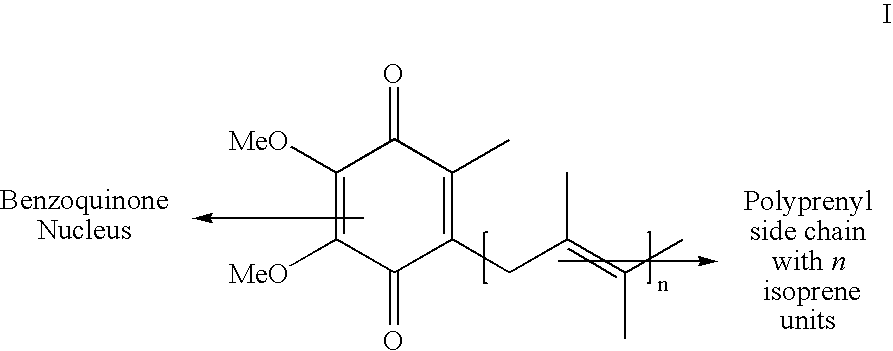Novel Intermediates Useful for the Preparation of Coenzymes, Process for the Preparation of Novel Intermediates and an Improved Process for the Preparation of Coenzymes
a technology of coenzyme and intermediate, which is applied in the preparation of carbonyl compounds, organic chemistry, chemistry apparatus and processes, etc., can solve the problems of high risk of explosion and toxic chemical, low yield of process nickel tetracarbonyl, and inability to use industrially, etc., to achieve high yield, cost-effective and commercially viable, and simple
- Summary
- Abstract
- Description
- Claims
- Application Information
AI Technical Summary
Benefits of technology
Problems solved by technology
Method used
Image
Examples
example 1
Preparation of Grignard Reagent of 2,3 Dimethoxy-5-bromo-6-methyl 1,4 dimethoxyethoxy methyl ether Compound of Formula IIb
[0139]2,3-Dimethoxy 5-methyl-1,4-benzoquinone of formula 2, (2.5 g) was dissolved in 7.5 ml of methylene dichloride and treated with sodium hydrosulphite (3.56 g) in an alkaline solution at 10-20° C. After 2 hours the reaction mixture was treated with conc. HCl (3.4 ml) to acidic pH. The reaction mixture was extracted with methylene dichloride and washed with water. The organic solvent was concentrated and poured in hexane. The precipitated solid was filtered to obtain 2.25 g of 2,3-dimethoxy-5-methyl-1,4-hydroquinone compound of formula 4. The solid was taken in methylene dichloride and treated with bromine (1.96 g) at 10 to 20° C. The reaction was quenched in water after 2 hours and extracted in methylene dichloride. The methylene dichloride was evaporated. The concentrated mass was added to hexane to precipitate out the solid of 2,3-dimethoxy-5-bromo-6-methyl-...
example 2
Preparation of Grignard Reagent of 2,3 Dimethoxy-5-bromo-6-methyl 1,4 dimethoxyethoxy methyl ether Compound of Formula IIb
[0140]2,3 dimethoxy 5-methyl 1,4 benzoquinone compound of formula 2 (2.5 g) was dissolved in 7.5 ml of methylene dichloride and treated with sodium hydrosulphite (3.56 g) in alkaline solution at 10-20° C. After 2 hours the reaction mixture was treated with conc. HCl 3.4 ml to acidic pH. The reaction mixture was extracted with methylene dichloride and washed with water. The organic solvent was concentrated and poured in hexane (10 ml). The precipitated solid was filtered to obtain 2.25 g of 2,3 dimethoxy 5 methyl 1,4 hydroquinone compound of formula 4. The solid was taken in methylene dichloride 15 ml and treated with bromine (1.96 g) at 10-20° C. The reaction was quenched in water after 2 hours and extracted in methylene dichloride. The methylene dichloride was evaporated. The concentrated mass was added to hexane to precipitate out the solid of 2,3 dimethoxy-5 b...
example 3
Preparation of Grignard Reagent of 2,3,4,5 tetramethoxy-6-methyl-bromobenzene Compound of Formula IIc
[0141]2,3dimethoxy-5-methyl 1,4 benzoquinone compound of formula 2, 2.5 g was dissolved in 7.5 ml of methylene dichloride and treated with sodium hydrosulphite (3.56 g) in alkaline solution at 10-20° C. After 2 hours the reaction mixture was treated with conc. HCl (3.4 ml) to acidic pH. The reaction mixture was extracted with methylene dichloride and washed with water. The organic solvent was concentrated and poured in hexane. The precipitated solid was filtered to obtain 2.25 g. of 2,3 dimethoxy 5 methyl 1,4 hydroquinone compound of formula 4. The solid was taken in alkaline solution and dimethyl sulphate (5.75 g) was added at 40-50° C. The reaction mixture was quenched after 4 hours in water and extracted in methylene dichloride. The solvent was evaporated and the crude obtained was distilled under vacuum at 80° C. at 0.5-1.0 mm Hg to obtain 2.33 g of 2,3,4,5-tetramethoxy toluene....
PUM
| Property | Measurement | Unit |
|---|---|---|
| Temperature | aaaaa | aaaaa |
| Temperature | aaaaa | aaaaa |
| Temperature | aaaaa | aaaaa |
Abstract
Description
Claims
Application Information
 Login to View More
Login to View More - R&D
- Intellectual Property
- Life Sciences
- Materials
- Tech Scout
- Unparalleled Data Quality
- Higher Quality Content
- 60% Fewer Hallucinations
Browse by: Latest US Patents, China's latest patents, Technical Efficacy Thesaurus, Application Domain, Technology Topic, Popular Technical Reports.
© 2025 PatSnap. All rights reserved.Legal|Privacy policy|Modern Slavery Act Transparency Statement|Sitemap|About US| Contact US: help@patsnap.com



